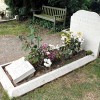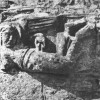We see that the following book is still on the shelves of bookshops. We reviewed the book on our earlier site, when it first appeared. For the benefit of new readers we thought it might be helpful to publish our review again.
BOOK REVIEW
Thomas Hardy: the Time-Torn Man
Claire Tomalin
Regular visitors to this site will likely have heard of the recent publication of Thomas Hardy: the Time-Torn Man, the latest addition to some dozen or so biographies of Dorset’s literary giant currently in and out of print, which includes Robert Gittings’ Hardy The Younger/Elder and several others. Author Claire Tomalin’s career as a journalist includes the literary editorship of the New Statesman and Sunday Times. As a biographer her impressive tally of seven previous titles includes Katherine Mansfield: a Secret Life; Jane Austen: a Life, and Samuel Pepys: the Unequalled Self. This last book was the 2002 Whitbread Book of the Year winner. Claire Tomalin is the wife of the well-known playwright and author Michael Frayn.
Time-Torn Man opens with a nine-page prologue in which we are plunged
at once into the melodramatic death-bed scenario of Hardy’s estranged first wife Emma. The author therefore has employed the presentational device of fixing the reader’s interest and attention by taking a time of tragedy in her subject’s later life before regressing to his genealogical beginnings and then working back up to and beyond the fulcrum or start point. Claire Tomalin thus throws light on how the couple’s matrimonial tragedy led to how the opening scenario came to be.
Tomalin is also at pains to explode the widespread myth that her subject was entirely a dour and melancholic recluse, striking a good balance with plenty of references to the social and sunny side of his nature, his partying, joking, and gaiety of his youth, active participation in local productions of his stories, etc. She further reveals the extent to which the author was a “man for ladies”, but does not neglect to mention both his kindness and unkindness towards his first wife Emma.
Of course Hardy’s childhood, architectural apprenticeship and numerous visits to and living seasons spent in London are well-documented. And the narrative is as notable for pointing out what might have been in the subject’s life, as for what actually did happen. Naturally, Hardy’s many works are given extensive coverage in the order of their writing, and Claire Tomalin writes at length upon the inspiration for them, and includes many transcriptions of verse-excerpts, sapped from the author’s romances and other circumstances. There is for instance much fine detail about the adverse critical and public reception to Jude the Obscure, though the biographer could also have included the detail that the book was publicly burnt.
While many of Hardy’s literary (and musical) contemporaries, friends and associates appear in the narrative, such as Browning, Wilde, Thackeray, Kipling, Rider Haggard, P T Lawrence, J M Barrie and Tennyson; even Elgar and Gustav Holst, I was surprised and a little disappointed to find several notable omissions. For example, that of Dorchester-born Court Surgeon and writer Frederick Treves, a lifelong friend from early youth; Dorset-born publisher and author Newman Flower, who befriended Hardy from about 1914 onwards, and once took him out on a picnic, and local composer Frederick Boyton Smith, who collaborated with Hardy in setting a number of his verses as songs. Also found wanting was the incidence of a visit to Max Gate by William Watkins, founder of the Society of Dorset Men in London, who died during the night after leaving Hardy that evening.
Thomas Hardy: Time-Torn Man comes as a two-inch thick, standard size hardback of 380 pages (not including another 105 pages of index and bibliography, etc). At the front there is a reproduction of a map of Dorchester and district as a double-pagespread and, more centrally placed, 33 monochrome photographs and sketches in two insertions within the text. The text itself is arranged in three parts or sections based upon ranges of years, corresponding with childhood/youth, middle years and later years, from the earliest (1840) up to 1928.
Published by Penguin-Viking



